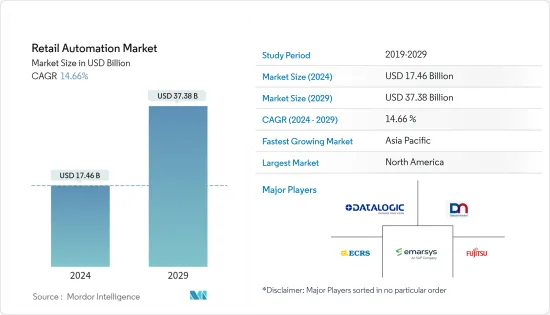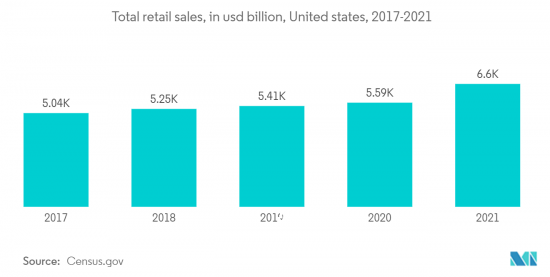PUBLISHER: Mordor Intelligence | PRODUCT CODE: 1403830

PUBLISHER: Mordor Intelligence | PRODUCT CODE: 1403830
Retail Automation - Market Share Analysis, Industry Trends & Statistics, Growth Forecasts 2024 - 2029

The Retail Automation Market size is estimated at USD 17.46 billion in 2024, and is expected to reach USD 37.38 billion by 2029, growing at a CAGR of 14.66% during the forecast period (2024-2029).
Key Highlights
- Retailers have recently faced challenges as the technological revolution has gained attention and adoption significantly. Such technologies and innovations have been reshaping the behavior of consumers and their way of collaborating and communicating pre - and post-sales. Features, such as convenience and transparency, provided by automation have been pushing retailers to adapt and upgrade their PoS systems. Furthermore, due to their cost-effectiveness, the demand for PoS systems has significantly risen among small retail stores.
- Retail automation assists with handling triggering reactions, interacting with other digital systems, and handling data. Cheaper operational risk, lower costs, a better customer experience, and increased productivity are just a few advantages of using this software.
- The requirement for human intervention can be minimized by using automation technologies to carry out repetitive operations like bookkeeping. The firm operates smoothly, efficiently, and consistently owing to automation, which can determine the shortest and most precise way to do the operation and repeat the process. With retail automation, shoppers may browse products using a touchscreen interface, and transactions take less time. The ability to choose the product of customers choosing and proceed to payment with a credit or debit card is made possible by retail automation.
- The growth further influences the market for machine learning capabilities incorporated into retail automation. Robotic process automation (RPA) uses artificial intelligence (AI) to provide better business insights and data integrity. Additionally, the retail automation market benefits from rising urbanization, a shift in lifestyle, an increase in expenditures, and higher consumer spending.
- The COVID-19 pandemic led retail businesses to take precautionary measures, which resulted in the closure of several outlets. Owing to this, retailers and leading luxury brands faced short-term challenges across sustained revenues, health and safety, supply chain management, labor shortages, and pricing, to name a few. With governments worldwide enforcing quarantines to curb the transmission of COVID-19, people staying back at home led to increased online shopping and bulk buying of goods. This resulted in massive supply chain stress. Thus, supply chain players among retailers deployed AI and smart analytics to ensure resilience.
Retail Automation Market Trends
Growth and Competition among Retail Industry and E -commerce
- With the usage of self-checkouts in stores, robotics, and artificial intelligence (AI) in supply chains, the retail industry has made progress in implementing automation. This is primarily a result of increased prices and wages, competitive labor markets, and decreased consumer spending. The sector is presently 40% automated, according to World Economic Forum (WEF) estimates, but over the next three to four years, this number might increase to 60-65%. The renewed focus on automation creates opportunities for logistics, robotics, and retailers.
- The growing strategic developments, such as investments and partnerships in recent years, are analyzed to contribute to the market growth rate significantly. For instance, In October 2022, Bumpa, a Nigerian retail automation platform, raised USD 4 million with Base10 Partners as the lead investor. The company disclosed a USD 200,000 pre-seed investment in September last year, saying it would utilize the money to expand into new African markets, acquire people, and improve its systems and structures.
- In October 2022, Walmart stated that it had acquired Alert Innovation, an e-grocery automation company that creates unique inventory-handling technology. According to the press release, Alert Innovation's Alphabot system uses omnidirectional robots instead of elevators or conveyors to store, retrieve, and dispense orders, freeing up space and making the technology easier to scale. The retail giant announced that it would partner with Alert to "scale their capabilities," noting that the technology will accelerate customer pickup and delivery. The retail giant said the Alphabot technology would enable it to utilize its vast store footprint for storage and fulfillment-4,700 stores located within 10 miles of 90% of the U.S. population.
- Microsoft is bringing together prominent players across all sectors of the retail space to help retailers enhance their delivery solutions to ultimately result in a positive customer experience. In January 2022, FarEye, a global SaaS platform, announced its selection by Microsoft as an Amplification Partner in Microsoft Cloud for Retail. The collaboration empowers and transforms how retailers orchestrate, track, and optimize the movement of goods, enabling enterprises to lower logistics costs while meeting the needs of end consumers.

North America is Expected to Hold Major Share
- The retail market in North America is one of the biggest. Wal-Mart, Costco, Kroger, Home Depot, and Target have their origins in this region. The rapidly growing data volume across in-store operations drives the market's growth. The retail automation market in the United States is expected to be driven by the growing adoption of automation technologies by major players such as Walmart and Amazon. Part of the adoption is also attributable to changing consumer preferences.
- Further, North America leads the demand for retail cloud solutions. The region has one of the most experimental retail scenarios compared to many other regions. Also, the use of cloud solutions in the region is high in specialty stores. For example, consider Bernhardt Furniture Company Inc., where the company used IBM's retail cloud solutions to create a mobile sales app and analytics platform that boosted the company's sales by approximately 20% in just ten weeks. Also, the company reported that its executives could engage around 205 more customers during sales events.
- According to the recent survey conducted by CitixsysTechnologies, the prominent vendors of cloud POS solutions (iVendRetail) based in the United States, over 67% of the respondents leave empty-handed from the store because they needed help finding the product they are looking The survey also reveals that over 51% of the respondents turn away from stores due to high waiting times at the POS (Point of service). Such info is very necessary for every retailer, and this is leading to the adoption of cloud solutions.
- In a retail cloud environment, retail businesses and retailers can move their infrastructure resources and business applications to different service architectures of the cloud, such as software as a service (SaaS), to gain a major advantage in terms of speed and agility. In the retail industry, SaaS is anticipated to hold a significant position during the forecast period compared to the other service models, as retailers have an affinity for enhancing customer-facing functionalities.
Retail Automation Industry Overview
The retail automation market is characterized by fragmentation, with numerous solution providers operating globally. Given the ongoing development of automation technology, competition among market players remains intense. Incumbent participants continuously invest heavily in research and development to deter potential entrants from disrupting their market share. Additionally, they explore expansion strategies to maximize their existing market footprint.
In May 2022, UST, a renowned digital transformation solutions provider with a presence in North America, announced the signing of an original equipment manufacturer agreement with SAP. This agreement enables the integration of the SAP Business Technology Platform (SAP BTP) into UST's CogniphiAI Vision platform, which will now be marketed as UST Sentry Vision AI. This Software as a Service (SaaS) packaged solution seamlessly interfaces with SAP S/4HANA and RISE with SAP, facilitating the incorporation of predictive, contextual, and analytical capabilities into retail and manufacturing operations through advanced video analytics. UST Sentry Vision AI, an advanced vision-based artificial intelligence technology, allows the identification of predictable patterns that can reduce operational waste, monitor performance, detect revenue leakage, and automate complex business operations. Businesses can leverage digital vision data and video analytics to gain a competitive edge with UST Sentry Vision AI. UST's artificial intelligence-based vision platform, integrated with SAP Business Technology Platform and SAP Analytics Cloud, empowers and accelerates the transition to an intelligent digital enterprise.
In May 2023, ECS Industrial Computer introduced an extensive range of new products for intelligent retail kiosks. This includes the LIVA Z5 Plus MiniPC series, such as B760H7-M8 and Q670HIS1 motherboards, designed for automation intelligence, information terminals, and lottery terminals.
Additional Benefits:
- The market estimate (ME) sheet in Excel format
- 3 months of analyst support
TABLE OF CONTENTS
1 INTRODUCTION
- 1.1 Study Assumptions and Market Definition
- 1.2 Scope of the Study
2 RESEARCH METHODOLOGY
3 EXECUTIVE SUMMARY
4 MARKET INSIGHTS
- 4.1 Market Overview
- 4.2 Industry Value Chain Analysis
- 4.3 Industry Attractiveness - Porter's Five Forces Analysis
- 4.3.1 Bargaining Power of Suppliers
- 4.3.2 Bargaining Power of Buyers
- 4.3.3 Threat of New Entrants
- 4.3.4 Threat of Substitute Products
- 4.3.5 Intensity of Competitive Rivalry
5 MARKET DYNAMICS
- 5.1 Market Drivers
- 5.1.1 Rising Demand for Quality and Fast Service
- 5.1.2 Growth and Competition among Retail Industry and E -commerce
- 5.2 Market Challenges
- 5.2.1 High Hardware Failure Rates
- 5.2.2 Huge Reliance on Internet and Connectivity
6 MARKET SEGMENTATION
- 6.1 By Type
- 6.1.1 Hardware
- 6.1.1.1 POS System
- 6.1.1.2 Self -checkout System
- 6.1.1.3 RFID and Barcode Scanners
- 6.1.1.4 Other Hardware Types
- 6.1.2 Software
- 6.1.1 Hardware
- 6.2 By End-User
- 6.2.1 Grocery (Supermarkets, Hypermarkets, Convenience Stores (with and without Fuel), and Drugstores)
- 6.2.2 General Merchandise (Hardgoods, Softgoods, and Mixed General Merchandise, like Departmental Stores, etc.)
- 6.2.3 Hospitality (Hotels (including Casinos, Resorts, Cruise Ships, etc.) and Restaurants)
- 6.3 Geography
- 6.3.1 North America
- 6.3.1.1 United States
- 6.3.1.2 Canada
- 6.3.2 Europe
- 6.3.2.1 United Kingdom
- 6.3.2.2 Germany
- 6.3.2.3 France
- 6.3.2.4 Rest of Europe
- 6.3.3 Asia-Pacific
- 6.3.3.1 China
- 6.3.3.2 Japan
- 6.3.3.3 India
- 6.3.3.4 Rest of Asia-Pacific
- 6.3.4 Latin America
- 6.3.5 Middle East & Africa
- 6.3.1 North America
7 COMPETITIVE LANDSCAPE
- 7.1 Company Profiles
- 7.1.1 Datalogic S.p.A
- 7.1.2 Diebold Nixdorf, Incorporated
- 7.1.3 ECR Software Corporation
- 7.1.4 Emarsys eMarketing Systems AG
- 7.1.5 Fiserv Inc.
- 7.1.6 Fujitsu Limited
- 7.1.7 Honeywell International Inc.
- 7.1.8 NCR Corporation
- 7.1.9 RapidPricer B.V.
- 7.1.10 Posiflex Technology Inc.
8 INVESTMENT ANALYSIS
9 FUTURE OF THE MARKET




